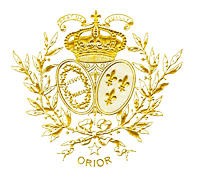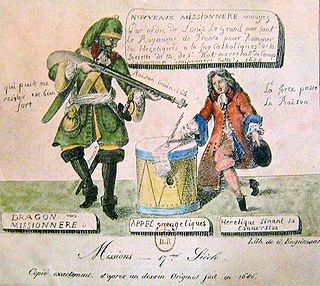| |||||
| Decades: | |||||
|---|---|---|---|---|---|
| See also: | Other events of 1712 History of France • Timeline • Years | ||||
Events from the year 1712 in France
| |||||
| Decades: | |||||
|---|---|---|---|---|---|
| See also: | Other events of 1712 History of France • Timeline • Years | ||||
Events from the year 1712 in France

The 1710s decade ran from January 1, 1710 to December 31, 1719.

1712 (MDCCXII) was a leap year starting on Friday of the Gregorian calendar and a leap year starting on Tuesday of the Julian calendar, the 1712th year of the Common Era (CE) and Anno Domini (AD) designations, the 712th year of the 2nd millennium, the 12th year of the 18th century, and the 3rd year of the 1710s decade. As of the start of 1712, the Gregorian calendar was 11 days ahead of the Julian calendar, which remained in localized use until 1923.

1708 (MDCCVIII) was a leap year starting on Sunday of the Gregorian calendar and a leap year starting on Thursday of the Julian calendar, the 1708th year of the Common Era (CE) and Anno Domini (AD) designations, the 708th year of the 2nd millennium, the 8th year of the 18th century, and the 9th year of the 1700s decade. As of the start of 1708, the Gregorian calendar was 11 days ahead of the Julian calendar, which remained in localized use until 1923.

The Prix de Rome or Grand Prix de Rome was a French scholarship for arts students, initially for painters and sculptors, that was established in 1663 during the reign of Louis XIV of France. Winners were awarded a bursary that allowed them to stay in Rome for three to five years at the expense of the state. The prize was extended to architecture in 1720, music in 1803 and engraving in 1804. The prestigious award was abolished in 1968 by André Malraux, then Minister of Culture, following the May 68 riots that called for cultural change.

MonsieurGaston, Duke of Orléans, was the third son of King Henry IV of France and his second wife, Marie de' Medici. As a son of the king, he was born a Fils de France. He later acquired the title Duke of Orléans, by which he was generally known during his adulthood. As the eldest surviving brother of King Louis XIII, he was known at court by the traditional honorific Monsieur.
The Bâtiments du Roi was a division of the Maison du Roi in France under the Ancien Régime. It was responsible for building works at the King's residences in and around Paris.

The College of Juilly is a Catholic private teaching establishment located in the commune of Juilly, in Seine-et-Marne (France). Directed by the French Oratorians, it was created in 1638 by the congregationists headed by Father Charles de Condren.
A Colonel General was an officer of the French army during the Ancien Régime, the French Revolution, the Napoleonic era and the Bourbon Restoration.
Events from the year 1842 in France.
The Commission des Sciences et des Arts was a French scientific and artistic institute. Established on 16 March 1798, it consisted of 167 members, of which all but 16 joined Napoleon Bonaparte's conquest of Egypt and produced the Description de l'Égypte. More than half were engineers and technicians, including 21 mathematicians, 3 astronomers, 17 civil engineers, 13 naturalists and mining engineers, geographers, 3 gunpowder engineers, 4 architects, 8 artists, 10 mechanical artists, 1 sculptor, 15 interpreters, 10 men of letters, 22 printers in Latin, Greek and Arabic characters. Bonaparte organised his scientific 'corps' like an army, dividing its members into 5 categories and assigning to each member a military rank and a defined military role beyond his scientific function.

The Galerie des Batailles is a gallery occupying the first floor of the Aile du Midi of the Palace of Versailles, joining onto the grand and petit appartement de la reine. 120 m (390 ft) long and 13 m (43 ft) wide, it is an epigone of the grand gallery of the Louvre and was intended to glorify French military history from the Battle of Tolbiac to the Battle of Wagram.

Victurnien Jean-Baptiste Marie de Rochechouart, prince of Tonnay-Charente then 9th duke of Mortemart was a French general and politician. He came from the Mortemart branch of the house of Rochechouart, named after the barony of Mortemart in Haute-Vienne, later raised to a marquisate and finally in December 1650 to a peer-duchy.
Events from the year 1714 in France

Neoclassicism is a movement in architecture, design and the arts which was dominant in France between about 1760 to 1830. It emerged as a reaction to the frivolity and excessive ornament of the baroque and rococo styles. In architecture it featured sobriety, straight lines, and forms, such as the pediment and colonnade, based on Ancient Greek and Roman models. In painting it featured heroism and sacrifice in the time of the ancient Romans and Greeks. It began late in the reign of Louis XV, became dominant under Louis XVI, and continued through the French Revolution, the French Directory, and the reign of Napoleon Bonaparte, and the Bourbon Restoration until 1830, when it was gradually replaced as the dominant style by romanticism and eclecticism.

Events from the year 1681 in France